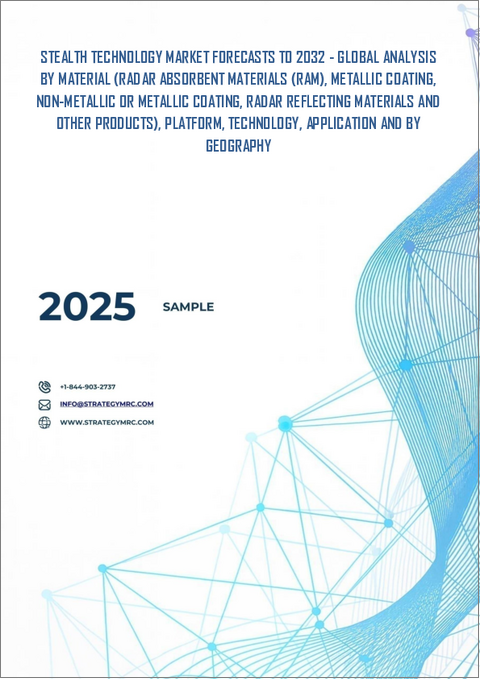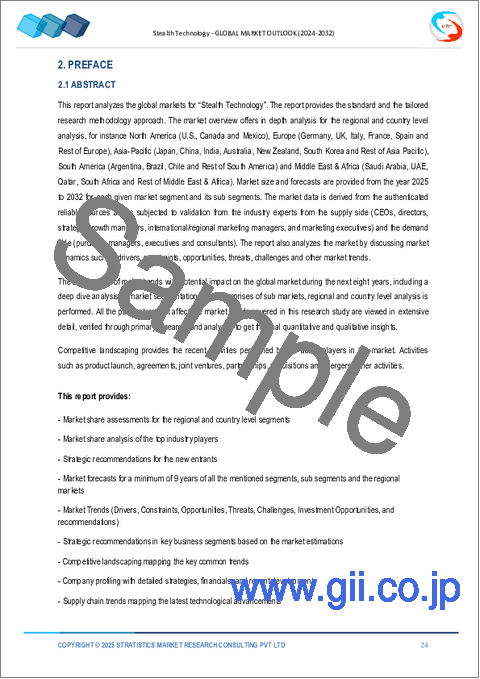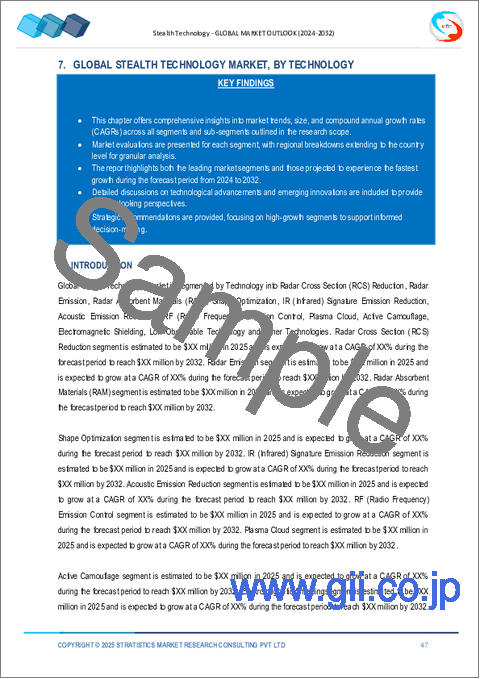|
|
市場調査レポート
商品コード
1734793
ステルス技術の2032年までの市場予測:材料、プラットフォーム、技術、用途、地域別の世界分析Stealth Technology Market Forecasts to 2032 - Global Analysis By Material (Radar Absorbent Materials, Metallic Coating, Non-metallic or Metallic Coating, Radar Reflecting Materials and Other Products), Platform, Technology, Application and By Geography |
||||||
カスタマイズ可能
|
|||||||
| ステルス技術の2032年までの市場予測:材料、プラットフォーム、技術、用途、地域別の世界分析 |
|
出版日: 2025年05月03日
発行: Stratistics Market Research Consulting
ページ情報: 英文 200+ Pages
納期: 2~3営業日
|
全表示
- 概要
- 図表
- 目次
Stratistics MRCによると、世界のステルス技術市場は2025年に516億6,000万米ドルを占め、予測期間中にCAGR 9.0%で成長し、2032年には944億4,000万米ドルに達すると予想されています。
レーダー、赤外線、ソナー、その他の探知技術によって航空機、船舶、潜水艦、ミサイルの探知可能性を低下させるために使用されるアプローチのコレクションは、ステルス技術、または低観測技術として参照されます。軍事資産が探知や追跡を回避できるようにするため、ステルス技術は、放射や反射を低くする特定の材料、形状、コーティングを使用します。現代の戦闘で頻繁に採用されているステルス技術は、敵対的なセンサーから見えにくくすることで、プラットフォームの生存率を高める。戦術的な利益を得るために、F-22ラプターやB-2スピリット爆撃機のような戦闘機で頻繁に使用されています。
軍事近代化計画
近代的な防衛システムへの大規模な投資は、戦略的優位性を維持するために国家が用いる戦略です。無人システム、艦艇、ステルス能力を持つ航空機の開発は、こうした構想の中で最優先されます。レーダーや赤外線などの追跡システムからの探知を低下させることで、ステルス技術は生存性を向上させる。世界の脅威の変化に伴い、低視認性プラットフォームの必要性は高まっています。その結果、防衛請負業者は、現代の戦場におけるステルス要求を満たすため、技術革新を加速させています。
高い開発・維持コスト
これらの技術には高度な材料、特殊なコーティング、精密なエンジニアリングが必要であるため、製造コストは増大します。小規模な防衛企業や新興経済国は、高額な初期支出によってこの産業への参入を躊躇しています。レーダーを吸収する素材や部品は繊細であるため、ステルス・システムを維持するのは極めて困難でコストがかかります。そのため、軍事事業者の長期的な所有費用がかさみ、配備の頻度も制限されます。このため、多くの防衛機関はより安価な選択肢を優先し、この分野全体の成長が鈍化しています。
無人航空機(UAV)への需要の高まり
UAVが軍事や監視任務でますます活用されるにつれて、悪条件下で生き残るためのUAVの能力を向上させる必要性が高まっています。UAVは、レーダー、赤外線、聴覚のフィンガープリントを低減するステルス技術のおかげで、検出がより困難になっています。戦闘任務、情報収集、偵察には、この能力が不可欠です。戦術的な優位性を得るため、世界中の政府や防衛機関はステルス機能を持つUAVに多額の投資を行っています。したがって、ステルス技術市場の成長は、UAVアプリケーションの台頭が直接の原動力となっています。
技術的陳腐化の可能性
現在のステルス能力は、量子レーダーやAI搭載センサーなど、探知技術の急速な向上によって追い越される危険性があります。その結果、国防機関や民間投資家は不明瞭になり、資金拠出をためらうようになります。頻繁なアップグレードに必要な費用と時間によって、普及には限界があります。さらに、ステルス・デバイスは、陳腐化した後は戦略的優位性をあまりもたらさないかもしれないです。市場の安定と成長は、このようなイノベーションとカウンター・イノベーションの終わりのない競争によって制約されます。
COVID-19の影響
COVID-19パンデミックはステルス技術市場に大きな影響を与え、防衛プロジェクトの遅延、予算の削減、サプライチェーンの混乱につながりました。しかし、地政学的緊張の継続と軍の近代化により、高度なステルス・システムに対する需要は引き続き旺盛でした。各国政府は長期的な防衛戦略に重点を移して適応し、市場の緩やかな回復につながりました。初期の後退にもかかわらず、ステルス技術分野は、防衛の優先順位と先端技術への投資がパンデミック後に勢いを取り戻すにつれて成長すると予想されます。
メタリックコーティング分野は予測期間中最大になる見込み
メタリックコーティング分野は、軍事資産のレーダー吸収能力を強化することで、予測期間中に最大の市場シェアを占めると予想されます。これらのコーティングは電磁波の反射を低減し、船舶、自動車、航空機を発見されにくくします。優れた耐久性と耐熱性は高度な金属材料によって提供され、高温や高速を伴う作業には不可欠です。ナノ構造メタリックコーティングの有効性と様々なプラットフォームにおける汎用性は、現在進行中の研究開発によってさらに強化されています。防衛機関がステルス性と生存性の向上を求めているため、高度なメタリックコーティングの必要性はますます高まっています。
予測期間中、CAGRが最も高いのは監視・偵察分野です。
予測期間中、監視・偵察分野が最も高い成長率を示すと予測されます。これは、探知されずに情報を収集できる低視認性プラットフォームの需要が高いためです。高度なステルス機能により、航空機、無人偵察機、艦艇は、容易に追跡されたり標的にされたりすることなく、敵地で活動することができます。これにより、任務の成功率が高まり、防衛軍の戦略的優位性が確保されます。レーダーを回避する素材や赤外線抑制の絶え間ない技術革新は、偵察作戦の効果を高める。世界の安全保障上の懸念が高まるにつれ、各国はステルス対応偵察システムに多額の投資を行い、市場拡大に拍車をかけています。
最大のシェアを占める地域:
予測期間中、アジア太平洋地域は、中国、インド、日本などの国々の防衛予算の増加により、最大の市場シェアを占めると予想されます。領土紛争や高度な監視システムの必要性といった地域の安全保障上の懸念が、ステルス航空機や無人航空機(UAV)への投資を促進しています。この地域の国防軍は、作戦効率を向上させるために最先端技術の採用を増やしています。政府と防衛メーカー間の協力的な取り組みと、軍事近代化プログラムの増加が、アジア太平洋市場の堅調な成長に寄与しています。
CAGRが最も高い地域:
予測期間中、北米地域が最も高いCAGRを示すと予測されるが、これは防衛費の増加と技術の進歩によるものです。米国は主要なプレーヤーであり、ステルス航空機、艦艇、レーダー回避システムを通じて軍事能力の強化に注力しています。これらの技術に対する需要は、新たな脅威に対抗するための高度な防衛ソリューションの必要性によって推進されています。戦略的投資と主要な防衛請負業者の存在も、競争力を維持するためのステルス能力の継続的な革新とともに、この地域の市場を後押ししています。
無料のカスタマイズ提供:
本レポートをご購読のお客様は、以下の無料カスタマイズオプションのいずれかをご利用いただけます:
- 企業プロファイル
- 追加市場プレーヤーの包括的プロファイリング(3社まで)
- 主要企業のSWOT分析(3社まで)
- 地域セグメンテーション
- 顧客の関心に応じた主要国の市場推計・予測・CAGR(注:フィージビリティチェックによる)
- 競合ベンチマーキング
- 製品ポートフォリオ、地理的プレゼンス、戦略的提携に基づく主要企業のベンチマーキング
目次
第1章 エグゼクティブサマリー
第2章 序文
- 概要
- ステークホルダー
- 調査範囲
- 調査手法
- データマイニング
- データ分析
- データ検証
- 調査アプローチ
- 調査資料
- 1次調査資料
- 2次調査情報源
- 前提条件
第3章 市場動向分析
- 促進要因
- 抑制要因
- 機会
- 脅威
- 技術分析
- 用途分析
- 新興市場
- COVID-19の影響
第4章 ポーターのファイブフォース分析
- 供給企業の交渉力
- 買い手の交渉力
- 代替品の脅威
- 新規参入業者の脅威
- 競争企業間の敵対関係
第5章 世界のステルス技術市場:材料別
- レーダー吸収材(RAM)
- メタリックコーティング
- 非金属または金属コーティング
- レーダー反射材
- 低視認性複合材料
- メタマテリアルとナノ複合材料
- その他の材料
第6章 世界のステルス技術市場:プラットフォーム別
- 空中
- 海軍
- 地上
- ミサイルシステム
- その他のプラットフォーム
第7章 世界のステルス技術市場:技術別
- レーダー反射断面積(RCS)の低減
- レーダー放射
- レーダー吸収材(RAM)
- 形状最適化
- IR(赤外線)シグネチャー放出低減
- 音響放出の低減
- RF(無線周波数)放出制御
- プラズマ雲
- アクティブカモフラージュ
- 電磁シールド
- 低視認性技術
- その他の技術
第8章 世界のステルス技術市場:用途別
- 軍隊
- 国土安全保障省
- 航空宇宙
- 商業
- 監視と偵察
- 戦闘作戦
- 電子戦
- その他の用途
第9章 世界のステルス技術市場:地域別
- 北米
- 米国
- カナダ
- メキシコ
- 欧州
- ドイツ
- 英国
- イタリア
- フランス
- スペイン
- その他欧州
- アジア太平洋
- 日本
- 中国
- インド
- オーストラリア
- ニュージーランド
- 韓国
- その他アジア太平洋地域
- 南米
- アルゼンチン
- ブラジル
- チリ
- その他南米
- 中東・アフリカ
- サウジアラビア
- アラブ首長国連邦
- カタール
- 南アフリカ
- その他中東とアフリカ
第10章 主な発展
- 契約、パートナーシップ、コラボレーション、ジョイントベンチャー
- 買収と合併
- 新製品発売
- 事業拡大
- その他の主要戦略
第11章 企業プロファイリング
- Lockheed Martin
- Northrop Grumman
- Boeing
- BAE Systems
- Raytheon Technologies
- General Dynamics
- Dassault Aviation
- Airbus Defence and Space
- Thales Group
- Textron
- Leonardo S.p.A.
- Mitsubishi Heavy Industries
- Elbit Systems
- Hindustan Aeronautics Limited(HAL)
- UAV Navigation
- Raytheon Missiles & Defense
- Saab Group
List of Tables
- Table 1 Global Stealth Technology Market Outlook, By Region (2024-2032) ($MN)
- Table 2 Global Stealth Technology Market Outlook, By Material (2024-2032) ($MN)
- Table 3 Global Stealth Technology Market Outlook, By Radar Absorbent Materials (RAM) (2024-2032) ($MN)
- Table 4 Global Stealth Technology Market Outlook, By Metallic Coating (2024-2032) ($MN)
- Table 5 Global Stealth Technology Market Outlook, By Non-metallic (2024-2032) ($MN)
- Table 6 Global Stealth Technology Market Outlook, By Radar Reflecting Materials (2024-2032) ($MN)
- Table 7 Global Stealth Technology Market Outlook, By Low-Observable Composites (2024-2032) ($MN)
- Table 8 Global Stealth Technology Market Outlook, By Metamaterials & Nanocomposites (2024-2032) ($MN)
- Table 9 Global Stealth Technology Market Outlook, By Other Materials (2024-2032) ($MN)
- Table 10 Global Stealth Technology Market Outlook, By Platform (2024-2032) ($MN)
- Table 11 Global Stealth Technology Market Outlook, By Aerial (2024-2032) ($MN)
- Table 12 Global Stealth Technology Market Outlook, By Naval (2024-2032) ($MN)
- Table 13 Global Stealth Technology Market Outlook, By Terrestrial (2024-2032) ($MN)
- Table 14 Global Stealth Technology Market Outlook, By Missile Systems (2024-2032) ($MN)
- Table 15 Global Stealth Technology Market Outlook, By Other Platforms (2024-2032) ($MN)
- Table 16 Global Stealth Technology Market Outlook, By Technology (2024-2032) ($MN)
- Table 17 Global Stealth Technology Market Outlook, By Radar Cross Section (RCS) Reduction (2024-2032) ($MN)
- Table 18 Global Stealth Technology Market Outlook, By Radar Emission (2024-2032) ($MN)
- Table 19 Global Stealth Technology Market Outlook, By Radar Absorbent Materials (RAM) (2024-2032) ($MN)
- Table 20 Global Stealth Technology Market Outlook, By Shape Optimization (2024-2032) ($MN)
- Table 21 Global Stealth Technology Market Outlook, By IR (Infrared) Signature Emission Reduction (2024-2032) ($MN)
- Table 22 Global Stealth Technology Market Outlook, By Acoustic Emission Reduction (2024-2032) ($MN)
- Table 23 Global Stealth Technology Market Outlook, By RF (Radio Frequency) Emission Control (2024-2032) ($MN)
- Table 24 Global Stealth Technology Market Outlook, By Plasma Cloud (2024-2032) ($MN)
- Table 25 Global Stealth Technology Market Outlook, By Active Camouflage (2024-2032) ($MN)
- Table 26 Global Stealth Technology Market Outlook, By Electromagnetic Shielding (2024-2032) ($MN)
- Table 27 Global Stealth Technology Market Outlook, By Low Observable Technology (2024-2032) ($MN)
- Table 28 Global Stealth Technology Market Outlook, By Other Technologies (2024-2032) ($MN)
- Table 29 Global Stealth Technology Market Outlook, By Application (2024-2032) ($MN)
- Table 30 Global Stealth Technology Market Outlook, By Military (2024-2032) ($MN)
- Table 31 Global Stealth Technology Market Outlook, By Homeland Security (2024-2032) ($MN)
- Table 32 Global Stealth Technology Market Outlook, By Aerospace (2024-2032) ($MN)
- Table 33 Global Stealth Technology Market Outlook, By Commercial (2024-2032) ($MN)
- Table 34 Global Stealth Technology Market Outlook, By Surveillance & Reconnaissance (2024-2032) ($MN)
- Table 35 Global Stealth Technology Market Outlook, By Combat Operations (2024-2032) ($MN)
- Table 36 Global Stealth Technology Market Outlook, By Electronic Warfare (2024-2032) ($MN)
- Table 37 Global Stealth Technology Market Outlook, By Other Applications (2024-2032) ($MN)
Note: Tables for North America, Europe, APAC, South America, and Middle East & Africa Regions are also represented in the same manner as above.
According to Stratistics MRC, the Global Stealth Technology Market is accounted for $51.66 billion in 2025 and is expected to reach $94.44 billion by 2032 growing at a CAGR of 9.0% during the forecast period. A collection of approaches used to reduce the detectability of aircraft, ships, submarines, and missiles by radar, infrared, sonar, and other detection techniques is referred to as stealth technology, or low observable technology. In order to enable military assets evade detection and tracking, it uses specific materials, forms, and coatings that lower emissions and reflection. Stealth technology, which is frequently employed in contemporary combat, increases a platform's survival by making it less visible to hostile sensors. To gain tactical benefits, it is frequently used in fighter jets like the F-22 Raptor and B-2 Spirit bomber.
Market Dynamics:
Driver:
Military modernization programs
Investing extensively in modern defence systems is a strategy used by nations to preserve strategic advantage. The development of unmanned systems, naval vessels, and aircraft with stealth capabilities is given top priority in these initiatives. By lowering detection from radar, infrared, and other tracking systems, stealth technology improves survivability. The need for low-observable platforms is growing as global threats change. As a result, defence contractors are speeding up innovation to satisfy the stealth demands of the contemporary battlefield.
Restraint:
High development and maintenance costs
Production costs are increased by these technologies' need for sophisticated materials, speciality coatings, and precise engineering. Smaller defence companies and emerging economies are deterred from entering the industry by the expensive initial expenditure. Because radar-absorbing materials and components are sensitive, maintaining stealth systems is extremely difficult and expensive. This raises the long-term ownership expenses for military operators and restricts the frequency of deployment. Because of this, many defence organisations give priority to less expensive options, which slows the growth of the sector as a whole.
Opportunity:
Growing demand for unmanned aerial vehicles (UAVs)
The necessity to improve UAVs' capacity to survive in adverse situations is growing as they are utilised more and more in military and surveillance missions. UAVs are more difficult to detect thanks to stealth technology, which reduces their radar, infrared, and auditory fingerprints. For combat missions, intelligence collection, and reconnaissance, this capacity is essential. To obtain tactical advantages, governments and defence organisations around the world are making significant investments in UAVs with stealth capabilities. Thus, the growth of the stealth technology market is directly driven by the rise of UAV applications.
Threat:
Potential for technological obsolescence
Current stealth capabilities are in danger of being surpassed by the rapid improvements in detection technology, such as quantum radar and AI-powered sensors. Defence organisations and private investors become unclear as a result, which makes them hesitant to contribute funds. Widespread adoption is limited by the expense and time required for frequent upgrades. Furthermore, stealth devices might not provide much of a strategic edge after they become obsolete. Market stability and growth are constrained by this never-ending competition between innovation and counter-innovation.
Covid-19 Impact
The COVID-19 pandemic significantly impacted the stealth technology market, leading to delays in defense projects, reduced budgets, and disrupted supply chains. However, the demand for advanced stealth systems remained strong due to ongoing geopolitical tensions and military modernization. Governments adapted by shifting focus to long-term defense strategies, leading to a gradual recovery in the market. Despite initial setbacks, the stealth technology sector is expected to grow as defense priorities and investments in advanced technologies regain momentum post-pandemic.
The metallic coating segment is expected to be the largest during the forecast period
The metallic coating segment is expected to account for the largest market share during the forecast period by enhancing radar-absorbing capabilities of military assets. These coatings reduce electromagnetic wave reflection, which makes ships, cars, and aeroplanes harder to spot. Superior durability and heat resistance are provided by advanced metallic materials, which are crucial for operations involving high temperatures or speeds. Nanostructured metallic coatings' effectiveness and versatility across a range of platforms are further enhanced by ongoing research and development. Advanced metallic coatings are becoming more and more necessary as defence agencies want increased stealth and survivability.
The surveillance & reconnaissance segment is expected to have the highest CAGR during the forecast period
Over the forecast period, the surveillance & reconnaissance segment is predicted to witness the highest growth rate, due to high demand for low-observable platforms that can gather intelligence undetected. Advanced stealth capabilities enable aircraft, drones, and naval vessels to operate in hostile territories without being easily tracked or targeted. This increases mission success rates and ensures strategic advantages for defense forces. Continuous innovation in radar-evading materials and infrared suppression enhances the effectiveness of reconnaissance operations. As global security concerns grow, nations invest heavily in stealth-enabled surveillance systems, fueling market expansion.
Region with largest share:
During the forecast period, the Asia Pacific region is expected to hold the largest market share due to rising defense budgets in countries like China, India, and Japan. Regional security concerns, such as territorial disputes and the need for advanced surveillance systems, have fueled investments in stealth aircraft and unmanned aerial vehicles (UAVs). The region's defense forces are increasingly adopting cutting-edge technologies to improve operational efficiency. Collaborative efforts among governments and defense manufacturers, along with growing military modernization programs, are contributing to the market's robust growth in Asia Pacific.
Region with highest CAGR:
Over the forecast period, the North America region is anticipated to exhibit the highest CAGR, owing to increasing defense expenditures and technological advancements. The United States, being a major player, focuses on enhancing military capabilities through stealth aircraft, naval vessels, and radar-evading systems. The demand for these technologies is driven by the need for advanced defense solutions to counter emerging threats. Strategic investments and the presence of key defense contractors also boost the region's market, with continuous innovation in stealth capabilities to maintain a competitive edge.
Key players in the market
Some of the key players profiled in the Stealth Technology Market include Lockheed Martin, Northrop Grumman, Boeing, BAE Systems, Raytheon Technologies, General Dynamics, Dassault Aviation, Airbus Defence and Space, Thales Group, Textron, Leonardo S.p.A., Mitsubishi Heavy Industries, Elbit Systems, Hindustan Aeronautics Limited (HAL), UAV Navigation, Raytheon Missiles & Defense and Saab Group.
Key Developments:
In January 2024, Northrop Grumman and Mitsubishi Electric signed a teaming agreement to collaborate on integrated air and missile defense capabilities for Japan's ground-based systems. This partnership aims to develop a networking solution integrating Japan's air and missile defense capabilities to share target information across various defense systems.
In January 2024, Lockheed Martin's Skunk Works unveiled the X-59, an experimental aircraft designed to reduce the loudness of sonic booms to a gentle "thump." This project aims to revolutionize supersonic flight over land by addressing one of its most persistent challenges.
In March 2023, Lockheed Martin and Tata Group entered into an agreement to produce fighter wing shipsets at their joint venture, Tata Lockheed Martin Aerostructures Limited (TLMAL) in Hyderabad, India. The production of 29 fighter wing shipsets was set to commence, supporting Lockheed Martin's F-21 offering for the Indian Air Force.
Materials Covered:
- Radar Absorbent Materials (RAM)
- Metallic Coating
- Non-metallic or Metallic Coating
- Radar Reflecting Materials
- Low-Observable Composites
- Metamaterials & Nanocomposites
- Other Materials
Platforms Covered:
- Aerial
- Naval
- Terrestrial
- Missile Systems
- Other Platforms
Technologies Covered:
- Radar Cross Section (RCS) Reduction
- Radar Emission
- Radar Absorbent Materials (RAM)
- Shape Optimization
- IR (Infrared) Signature Emission Reduction
- Acoustic Emission Reduction
- RF (Radio Frequency) Emission Control
- Plasma Cloud
- Active Camouflage
- Electromagnetic Shielding
- Low Observable Technology
- Other Technologies
Applications Covered:
- Military
- Homeland Security
- Aerospace
- Commercial
- Surveillance & Reconnaissance
- Combat Operations
- Electronic Warfare
- Other Applications
Regions Covered:
- North America
- US
- Canada
- Mexico
- Europe
- Germany
- UK
- Italy
- France
- Spain
- Rest of Europe
- Asia Pacific
- Japan
- China
- India
- Australia
- New Zealand
- South Korea
- Rest of Asia Pacific
- South America
- Argentina
- Brazil
- Chile
- Rest of South America
- Middle East & Africa
- Saudi Arabia
- UAE
- Qatar
- South Africa
- Rest of Middle East & Africa
What our report offers:
- Market share assessments for the regional and country-level segments
- Strategic recommendations for the new entrants
- Covers Market data for the years 2024, 2025, 2026, 2028, and 2032
- Market Trends (Drivers, Constraints, Opportunities, Threats, Challenges, Investment Opportunities, and recommendations)
- Strategic recommendations in key business segments based on the market estimations
- Competitive landscaping mapping the key common trends
- Company profiling with detailed strategies, financials, and recent developments
- Supply chain trends mapping the latest technological advancements
Free Customization Offerings:
All the customers of this report will be entitled to receive one of the following free customization options:
- Company Profiling
- Comprehensive profiling of additional market players (up to 3)
- SWOT Analysis of key players (up to 3)
- Regional Segmentation
- Market estimations, Forecasts and CAGR of any prominent country as per the client's interest (Note: Depends on feasibility check)
- Competitive Benchmarking
- Benchmarking of key players based on product portfolio, geographical presence, and strategic alliances
Table of Contents
1 Executive Summary
2 Preface
- 2.1 Abstract
- 2.2 Stake Holders
- 2.3 Research Scope
- 2.4 Research Methodology
- 2.4.1 Data Mining
- 2.4.2 Data Analysis
- 2.4.3 Data Validation
- 2.4.4 Research Approach
- 2.5 Research Sources
- 2.5.1 Primary Research Sources
- 2.5.2 Secondary Research Sources
- 2.5.3 Assumptions
3 Market Trend Analysis
- 3.1 Introduction
- 3.2 Drivers
- 3.3 Restraints
- 3.4 Opportunities
- 3.5 Threats
- 3.6 Technology Analysis
- 3.7 Application Analysis
- 3.8 Emerging Markets
- 3.9 Impact of Covid-19
4 Porters Five Force Analysis
- 4.1 Bargaining power of suppliers
- 4.2 Bargaining power of buyers
- 4.3 Threat of substitutes
- 4.4 Threat of new entrants
- 4.5 Competitive rivalry
5 Global Stealth Technology Market, By Material
- 5.1 Introduction
- 5.2 Radar Absorbent Materials (RAM)
- 5.3 Metallic Coating
- 5.4 Non-metallic or Metallic Coating
- 5.5 Radar Reflecting Materials
- 5.6 Low-Observable Composites
- 5.7 Metamaterials & Nanocomposites
- 5.8 Other Materials
6 Global Stealth Technology Market, By Platform
- 6.1 Introduction
- 6.2 Aerial
- 6.3 Naval
- 6.4 Terrestrial
- 6.5 Missile Systems
- 6.6 Other Platforms
7 Global Stealth Technology Market, By Technology
- 7.1 Introduction
- 7.2 Radar Cross Section (RCS) Reduction
- 7.3 Radar Emission
- 7.4 Radar Absorbent Materials (RAM)
- 7.5 Shape Optimization
- 7.6 IR (Infrared) Signature Emission Reduction
- 7.7 Acoustic Emission Reduction
- 7.8 RF (Radio Frequency) Emission Control
- 7.9 Plasma Cloud
- 7.10 Active Camouflage
- 7.11 Electromagnetic Shielding
- 7.12 Low Observable Technology
- 7.13 Other Technologies
8 Global Stealth Technology Market, By Application
- 8.1 Introduction
- 8.2 Military
- 8.3 Homeland Security
- 8.4 Aerospace
- 8.5 Commercial
- 8.6 Surveillance & Reconnaissance
- 8.7 Combat Operations
- 8.8 Electronic Warfare
- 8.9 Other Applications
9 Global Stealth Technology Market, By Geography
- 9.1 Introduction
- 9.2 North America
- 9.2.1 US
- 9.2.2 Canada
- 9.2.3 Mexico
- 9.3 Europe
- 9.3.1 Germany
- 9.3.2 UK
- 9.3.3 Italy
- 9.3.4 France
- 9.3.5 Spain
- 9.3.6 Rest of Europe
- 9.4 Asia Pacific
- 9.4.1 Japan
- 9.4.2 China
- 9.4.3 India
- 9.4.4 Australia
- 9.4.5 New Zealand
- 9.4.6 South Korea
- 9.4.7 Rest of Asia Pacific
- 9.5 South America
- 9.5.1 Argentina
- 9.5.2 Brazil
- 9.5.3 Chile
- 9.5.4 Rest of South America
- 9.6 Middle East & Africa
- 9.6.1 Saudi Arabia
- 9.6.2 UAE
- 9.6.3 Qatar
- 9.6.4 South Africa
- 9.6.5 Rest of Middle East & Africa
10 Key Developments
- 10.1 Agreements, Partnerships, Collaborations and Joint Ventures
- 10.2 Acquisitions & Mergers
- 10.3 New Product Launch
- 10.4 Expansions
- 10.5 Other Key Strategies
11 Company Profiling
- 11.1 Lockheed Martin
- 11.2 Northrop Grumman
- 11.3 Boeing
- 11.4 BAE Systems
- 11.5 Raytheon Technologies
- 11.6 General Dynamics
- 11.7 Dassault Aviation
- 11.8 Airbus Defence and Space
- 11.9 Thales Group
- 11.10 Textron
- 11.11 Leonardo S.p.A.
- 11.12 Mitsubishi Heavy Industries
- 11.11 Elbit Systems
- 11.14 Hindustan Aeronautics Limited (HAL)
- 11.15 UAV Navigation
- 11.16 Raytheon Missiles & Defense
- 11.17 Saab Group





